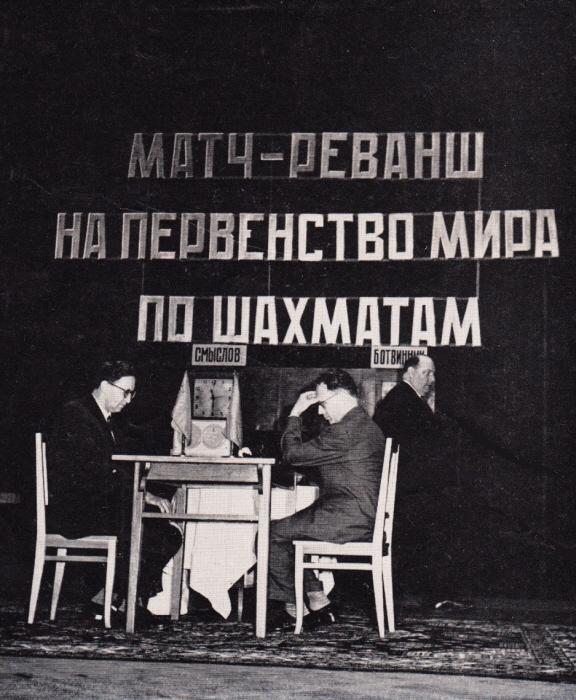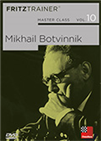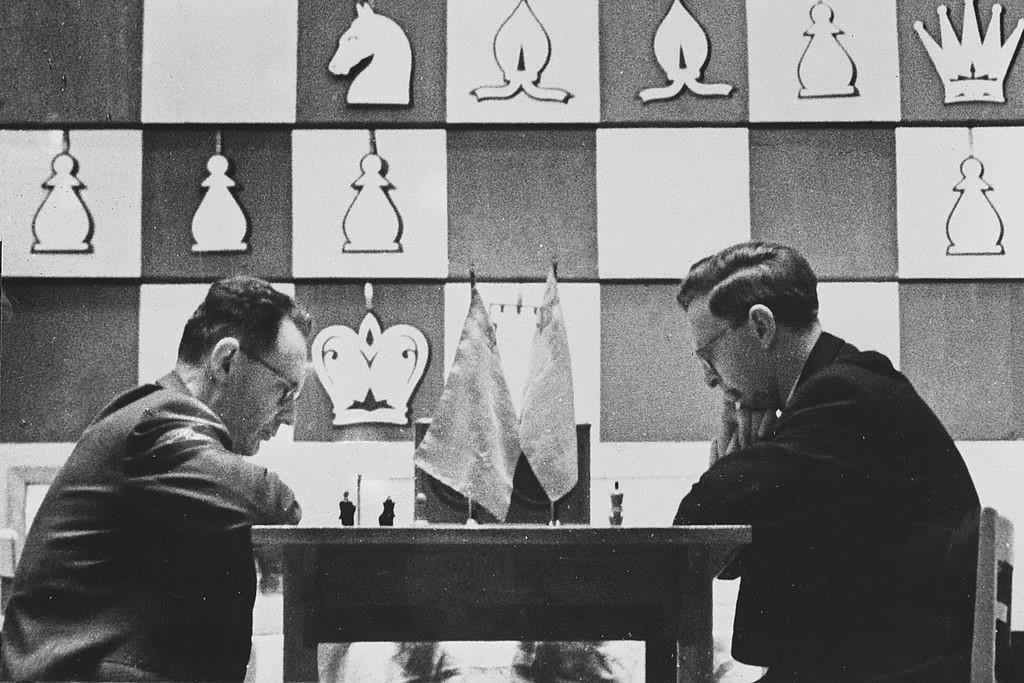Reclaiming the title
 Respectfully known as the Patriarch of Soviet chess, Mikhail Botvinnik became world champion for the first time in 1948, when he won a 5-player quintuple round robin finishing a whole three points ahead of second-placed Vasily Smyslov. Subsequently, he defended the title twice, first against David Bronstein (1951) and then against Smyslov (1954). In 1957, however, he was defeated by a 33-year-old Smyslov, who obtained a clear 12½:9½ victory in Moscow.
Respectfully known as the Patriarch of Soviet chess, Mikhail Botvinnik became world champion for the first time in 1948, when he won a 5-player quintuple round robin finishing a whole three points ahead of second-placed Vasily Smyslov. Subsequently, he defended the title twice, first against David Bronstein (1951) and then against Smyslov (1954). In 1957, however, he was defeated by a 33-year-old Smyslov, who obtained a clear 12½:9½ victory in Moscow.
As the FIDE rules allowed at the time, the player who lost the title had a chance to play a rematch against the newly crowned champion. Thus, in March 1958, Botvinnik faced Smyslov once again in a 24-game match. Both times that Botvinnik had defended the title — in 1951 and 1954 — he had only managed to do it by tying the score, as back then this meant the holder retained the championship. This time around, however, Botvinnik kicked off with three straight victories and went on to win the match 12½:10½.
[Pictured: Botvinnik and Smyslov during the 1958 match | Photo: Chess Review, July 1958]
 Our experts show, using the games of Botvinnik, how to employ specific openings successfully, which model strategies are present in specific structures, how to find tactical solutions and rules for how to bring endings to a successful conclusion
Our experts show, using the games of Botvinnik, how to employ specific openings successfully, which model strategies are present in specific structures, how to find tactical solutions and rules for how to bring endings to a successful conclusionCuriously, this was the second time Botvinnik played without a second, as during the 1954 match he felt that someone was leaking information to Smyslov, who was too ready to face opening variations that he had not used in the past.
Another peculiarity of this match was that Botvinnik lost the 15th game on time, despite having a superior position and only needing to make two moves in three minutes. As published on Edward Winter’s Chess Notes, Botvinnik himself wrote in Botvinnik-Smyslov Three World Chess Championship Matches: 1954, 1957, 1958 (Alkmaar, 2009):
As I sat there, absorbed in these thoughts, great was my astonishment when the chief arbiter Ståhlberg came over to our table and announced that Black had lost on time. Having two-three minutes for a couple of moves, I had simply forgotten all about the clock and had exceeded the time limit.
However, this article will focus on an earlier game, thanks to a suggestion made by JNorri, who wrote: “For the future: I would suggest the 14th game of the 1958 Smyslov-Botvinnik match. Botvinnik called it maybe his most subtle rook ending.”
In his long career, Botvinnik had many famous rook endings — we have already dealt with his epic fight against Bobby Fischer from 1962. Now comes a duel with another world champion who was also an endgame virtuoso.
It seems that a few mistakes have not been discovered yet. Can you find them?
Please share any analysis you come up with on the comments section. You may also like to use more powerful engines to assist you in your efforts. Fat Fritz, for instance, goes for some unconventional continuations and surprises. I will evaluate your submissions and discuss them with you.
In over 4 hours in front of the camera, Karsten Müller presents to you sensations from the world of endgames - partly reaching far beyond standard techniques and rules of thumb - and rounds off with some cases of with own examples.
Links


















 Respectfully known as the Patriarch of Soviet chess, Mikhail Botvinnik became world champion for the first time in 1948, when he won a 5-player quintuple round robin finishing a whole three points ahead of second-placed Vasily Smyslov. Subsequently, he defended the title twice, first against David Bronstein (1951) and then against Smyslov (1954). In 1957, however, he was defeated by a 33-year-old Smyslov, who obtained a clear 12½:9½ victory in Moscow.
Respectfully known as the Patriarch of Soviet chess, Mikhail Botvinnik became world champion for the first time in 1948, when he won a 5-player quintuple round robin finishing a whole three points ahead of second-placed Vasily Smyslov. Subsequently, he defended the title twice, first against David Bronstein (1951) and then against Smyslov (1954). In 1957, however, he was defeated by a 33-year-old Smyslov, who obtained a clear 12½:9½ victory in Moscow. 




